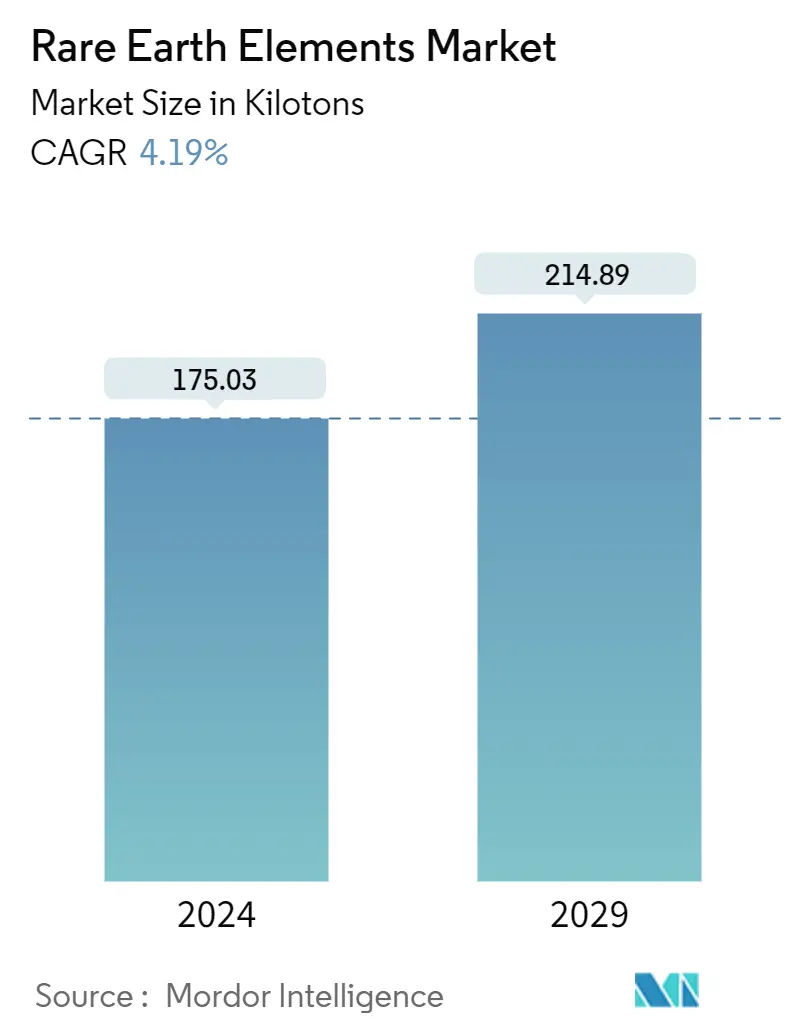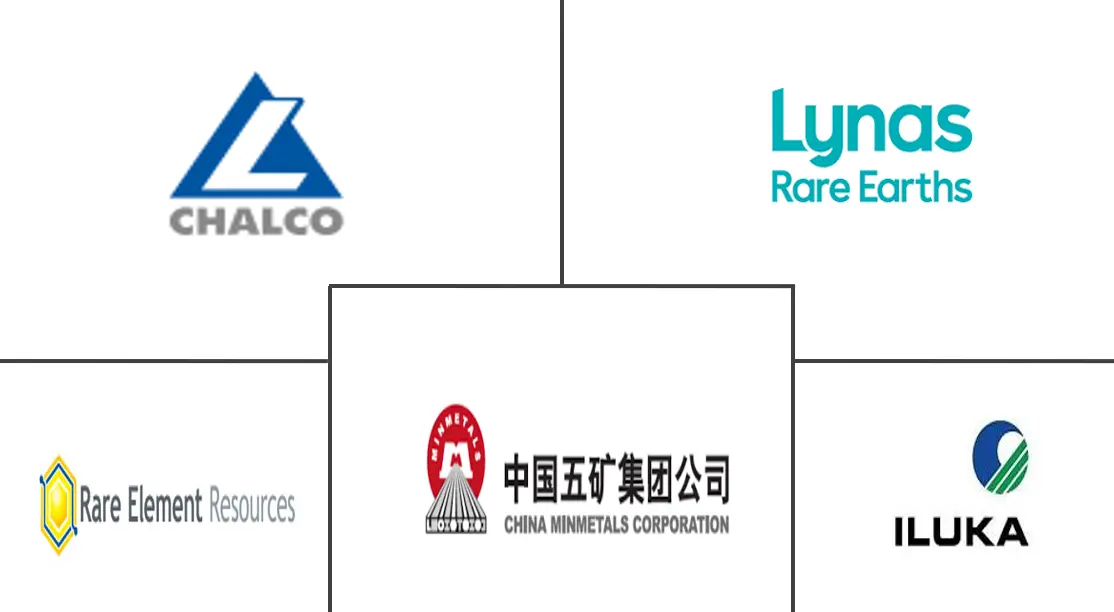Market Size of Rare Earth Elements Industry

| Study Period | 2019-2029 |
| Base Year For Estimation | 2023 |
| CAGR (2024 - 2029) | 4.19 % |
| Fastest Growing Market | Asia-Pacific |
| Largest Market | Asia-Pacific |
| Market Concentration | Low |
Major Players
*Disclaimer: Major Players sorted in no particular order |
Rare Earth Elements Market Analysis
The Rare Earth Elements Market size is estimated at 175.03 kilotons in 2024, and is expected to reach 214.89 kilotons by 2029, growing at a CAGR of 4.19% during the forecast period (2024-2029).
COVID-19 negatively impacted the demand for rare earth elements as the global demand witnessed a slowdown following stringent containment restrictions for a long time. However, the situation gradually improved in 2021 with the global economy's revival and industrial activities' resumption.
- The factors driving the market's growth are the high demand from emerging economies and dependency on "Green Technology" on rare Earth elements.
- On the flip side, an inconsistent supply of rare earth elements may act as a barrier to the market's growth.
- The increasing scandium usage in aerospace applications will likely provide opportunities for the market during the forecast period.
- Asia-Pacific dominated the global market, owing to the increasing production of rare Earth metals and rising demand from industries such as consumer electronics.
Rare Earth Elements Industry Segmentation
Rare Earth elements are used in loudspeakers, telescope lenses, studio lighting, and computer hard drives to make them smaller and more efficient. They are used in screens and displays as they can produce different colors. Rare Earth elements usually have high electrical conductivity, naturally occurring together in minerals. They are the strongest magnets available today.
The market is segmented by element, application, and geography. By element, the market is segmented into cerium, neodymium, lanthanum, dysprosium, terbium, yttrium and scandium, and other elements. By application, the market is segmented into catalysts, ceramics, phosphors, glass and polishing, metallurgy, magnets, and other applications. The report also covers the market sizes and forecasts for the rare earth elements market in 15 countries across the major regions. For each segment, the market sizing and forecasts have been done based on volume (ton).
| Element | |||||
| |||||
| |||||
| |||||
| Dysprosium | |||||
| Terbium | |||||
| Yttrium | |||||
| Scandium | |||||
| Other Elements |
| Application | |
| Catalysts | |
| Ceramics | |
| Phosphors | |
| Glass and Polishing | |
| Metallurgy | |
| Magnets | |
| Other Applications |
| Geography | |||||||
| |||||||
| |||||||
| |||||||
| |||||||
|
Rare Earth Elements Market Size Summary
The rare earth elements market is poised for growth, driven by increasing demand from emerging economies and the critical role these elements play in green technology. The market experienced a downturn due to the COVID-19 pandemic, but recovery began in 2021 as global industrial activities resumed. The Asia-Pacific region leads the market, largely due to its significant production capabilities and rising demand from sectors like consumer electronics. However, the market faces challenges such as inconsistent supply, which could hinder growth. Opportunities are emerging in the aerospace sector, particularly with the growing use of scandium. The market is characterized by a fragmented landscape with numerous players, including Lynas Rare Earths Ltd and Iluka Resources Limited, who are actively expanding their operations to meet the increasing demand.
Magnets represent one of the largest applications for rare earth elements, with extensive use across industries such as electronics, automotive, power generation, and healthcare. The automotive sector, in particular, is seeing a rise in demand for neodymium-incorporated permanent magnet motors, which are crucial for electric vehicles and wind turbines. The healthcare industry also contributes to the demand through the use of magnets in medical equipment like MRI machines and pacemakers. The Asia-Pacific region's dominance in the market is further bolstered by its robust electronics production base and significant investments in healthcare and ceramics. Countries like Japan and India are actively working to reduce their dependency on Chinese imports and increase their domestic production capabilities, which is expected to have a substantial impact on the market dynamics in the coming years.
Rare Earth Elements Market Size - Table of Contents
-
1. MARKET DYNAMICS
-
1.1 Drivers
-
1.1.1 High Demand from Emerging Economies
-
1.1.2 Dependency of 'Green Technology' on Rare Earth Elements
-
-
1.2 Restraints
-
1.2.1 Inconsistent Supply of Rare Earth Elements
-
-
1.3 Industry Value Chain Analysis
-
1.4 Porter's Five Forces Analysis
-
1.4.1 Bargaining Power of Suppliers
-
1.4.2 Bargaining Power of Consumers
-
1.4.3 Threat of New Entrants
-
1.4.4 Threat of Substitute Products and Services
-
1.4.5 Degree of Competition
-
-
-
2. MARKET SEGMENTATION (Market Size in Volume)
-
2.1 Element
-
2.1.1 Cerium
-
2.1.1.1 Oxide
-
2.1.1.2 Sulfide
-
2.1.1.3 Other Elements
-
-
2.1.2 Neodymium
-
2.1.2.1 Alloy
-
-
2.1.3 Lanthanum
-
2.1.3.1 Alloy
-
2.1.3.2 Oxide
-
2.1.3.3 Other Elements
-
-
2.1.4 Dysprosium
-
2.1.5 Terbium
-
2.1.6 Yttrium
-
2.1.7 Scandium
-
2.1.8 Other Elements
-
-
2.2 Application
-
2.2.1 Catalysts
-
2.2.2 Ceramics
-
2.2.3 Phosphors
-
2.2.4 Glass and Polishing
-
2.2.5 Metallurgy
-
2.2.6 Magnets
-
2.2.7 Other Applications
-
-
2.3 Geography
-
2.3.1 Asia-Pacific
-
2.3.1.1 China
-
2.3.1.2 India
-
2.3.1.3 Japan
-
2.3.1.4 South Korea
-
2.3.1.5 Rest of Asia-Pacific
-
-
2.3.2 North America
-
2.3.2.1 United States
-
2.3.2.2 Canada
-
2.3.2.3 Mexico
-
-
2.3.3 Europe
-
2.3.3.1 Germany
-
2.3.3.2 United Kingdom
-
2.3.3.3 France
-
2.3.3.4 Italy
-
2.3.3.5 Rest of Europe
-
-
2.3.4 South America
-
2.3.4.1 Brazil
-
2.3.4.2 Argentina
-
2.3.4.3 Rest of South America
-
-
2.3.5 Middle East and Africa
-
2.3.5.1 Saudi Arabia
-
2.3.5.2 South Africa
-
2.3.5.3 Rest of Middle East and Africa
-
-
-
Rare Earth Elements Market Size FAQs
How big is the Rare Earth Elements Market?
The Rare Earth Elements Market size is expected to reach 175.03 kilotons in 2024 and grow at a CAGR of 4.19% to reach 214.89 kilotons by 2029.
What is the current Rare Earth Elements Market size?
In 2024, the Rare Earth Elements Market size is expected to reach 175.03 kilotons.

